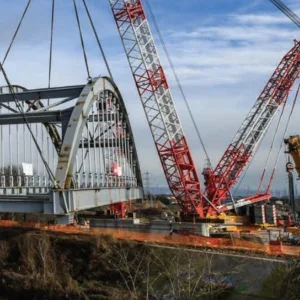
An entrant works with pulley reeving at an Ironworkers’ apprentice competition in 2006
All apprentices are required to study rigging techniques and working with cranes. This will qualify them for later work slinging loads, assembling and disassembling cranes, as part of their trade in steel erection, reinforcing and working with metals.
“We are trying to make sure that people are employable, safe, educated, and know what they are doing,” says Frank Migliaccio, the union’s executive director of safety and health.
The days of closed shops are now gone, Migliaccio says. “If you look at large cities and look at the immigration, there is bound to be a non-union labour pool.” He says that in Washington DC, where he works, the market is non-union, but contractors hire union ironworkers because they are trained.
“Contractors are watching their people, and if they don’t know what they are doing, they will send them back to the hall,” Migliaccio says. “They don’t want unsafe people, they don’t want unskilled people, and I don’t blame them.”

Ironworkers’ new rigging manual
The rigging course includes sections on new rigging hardware, rigging procedures, and rigging with hydraulic gantries. It was finished earlier this year. The cranes course includes load charts, pre-lift planning and set-up procedures, erecting and climbing tower cranes, and operation procedures. It is due to be finished in June. Both books adapt material produced by the Construction Safety Association of Ontario, Canada.
The crane course focuses on setting up cranes, and other structures (although it does not actually teach crane driving, which is handled by the the International Union of Operating Engineers). “We work closely with crane operators,” Migliaccio says. “We need to know the lifting capacity, how to rig and disassemble them. Things change through the years; there are a lot of computers on cranes now. We are doing away with anything that is not in the market today.”
The course is from three to four years long, depending on the local, with a yearly minimum of 204 classroom hours and 2,000 jobsite training hours, with pay rises every six to nine months. The apprentices are assessed at the end of the course, and earn the title of ‘journeyman’.
The amount of time spent on the material varies from local hall to local hall, depending partly on the special demand from the local construction industry, but the union requires a minimum of 80 hours for the rigging and crane course.
Journeymen can return to the union hall for further instruction—called ‘upgrading’—but only on a voluntary basis, Migliaccio says. Other trades, such as welding or post-tensioning, are required to return for particular training, but this requirement depends on contractors’ needs.
Apprentices do not pay for training. The schools, instructors and teaching materials are paid for by the union (in turn funded by union dues paid by the apprentice) and by employers.
The rigging programme can also lead to a rigger card qualification. Rigging manufacturer Crosby trains Ironworkers instructors during the union’s annual week-long training conference in San Diego, California. Then instructors can issue qualified rigger cards to students who pass their exams. This programme began two years ago, Sullivan says.
The union is now planning to translate the rigging textbook into Spanish, Sullivan says, although the course would still be conducted in English.
“One thing we make sure of through the union: healthcare, that’s important, insurance, that’s important,” Migliaccio says. “We are taking people who come into the country, and who are working legally, and who may have a language barrier, and we are working on this. We have Hispanic instructors, and we also teach English in some locals. My great-grandfather couldn’t speak English when he came from Italy. He had to learn somehow. We’re going to take care of the people.”
An entrant works with pulley reeving at an Ironworkers’ apprentice competition in 2006 Ironworker apprentice competition Ironworkers’ new rigging manual Ironworkers’ rigging manual






